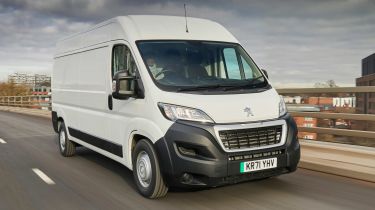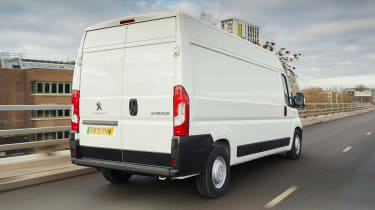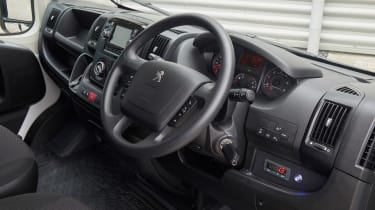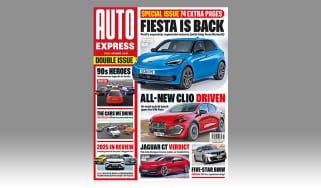New Peugeot e-Boxer van 2022 review
The new all-electric Peugeot e-Boxer van prioritises load volume over range and power
Verdict
A short range and low power mean that the electric Peugeot e-Boxer fits a very specific brief in the large van market. If you need a vehicle that majors on cargo volume, rather than payload weight, and you plan to do only a few miles each day, then it's worth considering. But there are better electric vans out there that feel better integrated with their electric running gear. The similar Fiat e-Ducato is a case in point, and should be the template that Peugeot should adapt to if it wants the e-Boxer to be more competitive.
The market for large electric vans is a busy one, so the Peugeot e-Boxer has a tough fight on its hands. It has launched alongside the mechanically identical Citroen e-Relay, so it features the same electric drivetrain. This is fitted to the van by a conversion company based in Turkey, so while the standard Boxer rolls off the same production line as the Fiat e-Ducato, Peugeot then ships its vans off to be converted to electric drive. It's a bit of a long-winded process when you consider another electric van runs off the same production line, but it's a remnant of the fact the Peugeot and Fiat were developed separately, before both companies were brought closer together within the Stellantis group.
Used - available now

2025 Toyota
RAV4 Hybrid
13,860 milesAutomaticPetrol2.5L
Cash £34,826
2022 Toyota
C-HR
37,512 milesAutomaticPetrol1.8L
Cash £20,023
2022 Toyota
bZ4X
18,000 milesAutomaticElectric
Cash £26,928
2023 Vauxhall
Mokka
42,451 milesAutomaticPetrol1.2L
Cash £13,390As well as the e-Ducato and e-Relay, the e-Boxer's other rivals in the large electric van class include the Mercedes eSprinter and Renault Master E-Tech (formerly the Master ZE), while other rivals include the Maxus eDeliver 9 and the forthcoming Ford e-Transit.
There are two batteries offered in the Peugeot e-Boxer. The entry point to the range is the L2H2 van with a 37kWh pack, while the remainder of the vans (the L3H2 driven here, plus L4H2 panel van in standard and window van guises) feature a 70kWh pack. Driving range for the 37kWh van is a short 73 miles under WLTP conditions, while the 70kWh battery increases that to 139 miles. For reference, the e-Ducato has batteries of 47 or 79kWh, and a promise of a range of up to 230 miles. These vans are designed with short, last-mile delivery routes as their main focus, though, so there should be enough range for a day's work in the 70kWh van at least.
If you do need to charge up, the e-Boxer features 50kW rapid charging as standard, which means fast DC charging from 0-80 per can be done in an hour. This time applies for both batteries, but AC charging varies between pack sizes. The 37kWh battery takes three hours to charge via a 22kW source, compared with nine hours for the 70kWh pack, while the times are six or 12 hours from a 7.4kW chargepoint. The van's charging socket is located in the same place as the fuel filler for the diesel van, just behind the passenger door.
Get in the cab, and the e-Boxer looks largely identical to the standard van, save for a couple of very minor changes and a glaringly obvious one. The big change is the removal of the van's gearlever. While the smaller e-Partner and e-Expert use the same neat looking toggle drive selector found in Peugeot's electric passenger cars, the e-Boxer features a large plastic blank and a trio of silver metal buttons to press to select Drive, Neutral and Reverse. It's not as nicely integrated, though, and feels like an aftermarket addition, even if selecting the right drive mode is simple enough.
There's another silver button down to the right of the steering wheel which activates the cabin heater. Since the e-Boxer ditches diesel, the standard heater system has gone, too, so a new system has to be fitted as part of the conversion. The power button sits next to a digital thermostat display that shows the current cabin temperature and allows you to set a maximum, too. It's a bit of a fiddly system to use, and it means the driver is the only one who can control the warmth of the cabin, although the diesel van's fan control and air distribution settings can still be operated.
If you want to check the charge status of the battery and how much range you have, then you need to look in the rear-view mirror. Rather than combine this information into the standard-fit 5.0-inch touchscreen on the centre console, Peugeot has added a digital display in the corner of the mirror. It's another thing to get used to when driving, but again it makes the whole electrification experience feel more like an aftermarket conversion than a genuine Peugeot product.
The other major quirk of the cabin is found with the dials directly ahead of the driver. The analogue dials are the same as the ones found in the Boxer diesel, but only the speedometer has a needle. The rev counter, fuel gauge and water temperature are needle-free since they are not used. At least it's better than being left with gaping holes where the redundant read-outs would be.
Locating the drive battery under the e-Boxer's cargo floor means its carrying capacity hasn't been harmed. There's up to 15 cubic metres of cargo space on offer in the largest version of the e-Boxer, and even the smallest L2H2 model has 11.5 cubic metres of space. Payloads range from 740kg for the 3.5-tonne version of the e-Boxer, up to 1.15 tonnes for the four-tonne variant.
The e-Boxer comes with a 118bhp electric motor and this modest power output means this big van is relatively sedate in its performance. There's no instant hit of acceleration (which is probably a good thing, because the battery range would take a beating), and the van gradually gathers pace instead. If you're taking it easy, then this is fine, but if you need a quick shot of acceleration - when entering a busy roundabout, for example - you're not going to get it here.
At least the van is quiet when compared with the Boxer diesel. Peugeot's big van has always been a bit rough and ready when compared with rivals, but electric drive adds a new, serene calm to the van. It really encourages you to take a relaxed approach - which is helped by the lack of power – although the constant whistle of the electric motor could start to grate after a long day at the wheel.
Still, when you're moving, the e-Boxer keeps pace with traffic reasonably well at urban speeds, while cruising at 60mph on the motorway isn't a big deal - the van's limited to 75mph anyway, and the range will take a major hiding if you go any faster. The van offers some energy recovery when you lift off the throttle, but we found it to be a bit inconsistent. Sometimes the van would slow fairly progressively, while at other times it seemed to coast along. There's no facility to adjust the level of energy recovery.
Light steering means manoeuvring is straightforward, and selecting between drive and reverse is simplicity in itself, with a press of the relevant button on the dashboard. Standard-fit rear parking sensors help you to judge where the back of this 5.4-metre long van is, while a rear beeper ensures other road users know when you're reversing, too. Unfortunately forward visibility could be better. The vast windscreen and tall, forward-set driving position give a clear view ahead, but at junctions the van's A-pillars and door frames can obscure your view.
If you need a large electric van as soon as possible, then the Peugeot e-Boxer is available for delivery straight away, but you'll have to be prepared to make compromises. The electric set-up isn't the best available, while the fit and finish of the system isn't as well integrated as that found in rival models. If you're only covering short urban mileages and need cargo volume over payload weight, then it could be the solution that you need.
| Model: | Peugeot e-Boxer L3H2 70 kWh Panel Van Professional |
| Price: | From £57,035 (incl £5,000 PiVG) |
| Powertrain: | 70kWh battery, 118bhp electric motor |
| Transmission: | Single-speed auto, front-wheel drive |
| Top speed: | 75mph |
| WLTP Range: | 139 miles |
| Maximum payload: | 740kg |
| Cargo volume: | 13 cubic metres |
| On sale: | Now |







